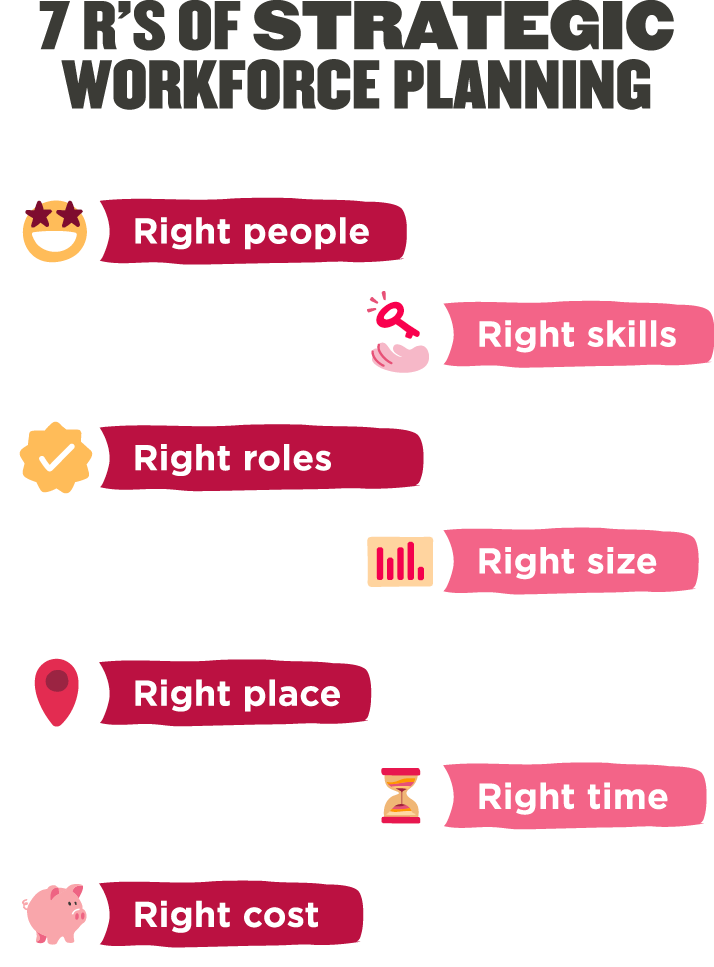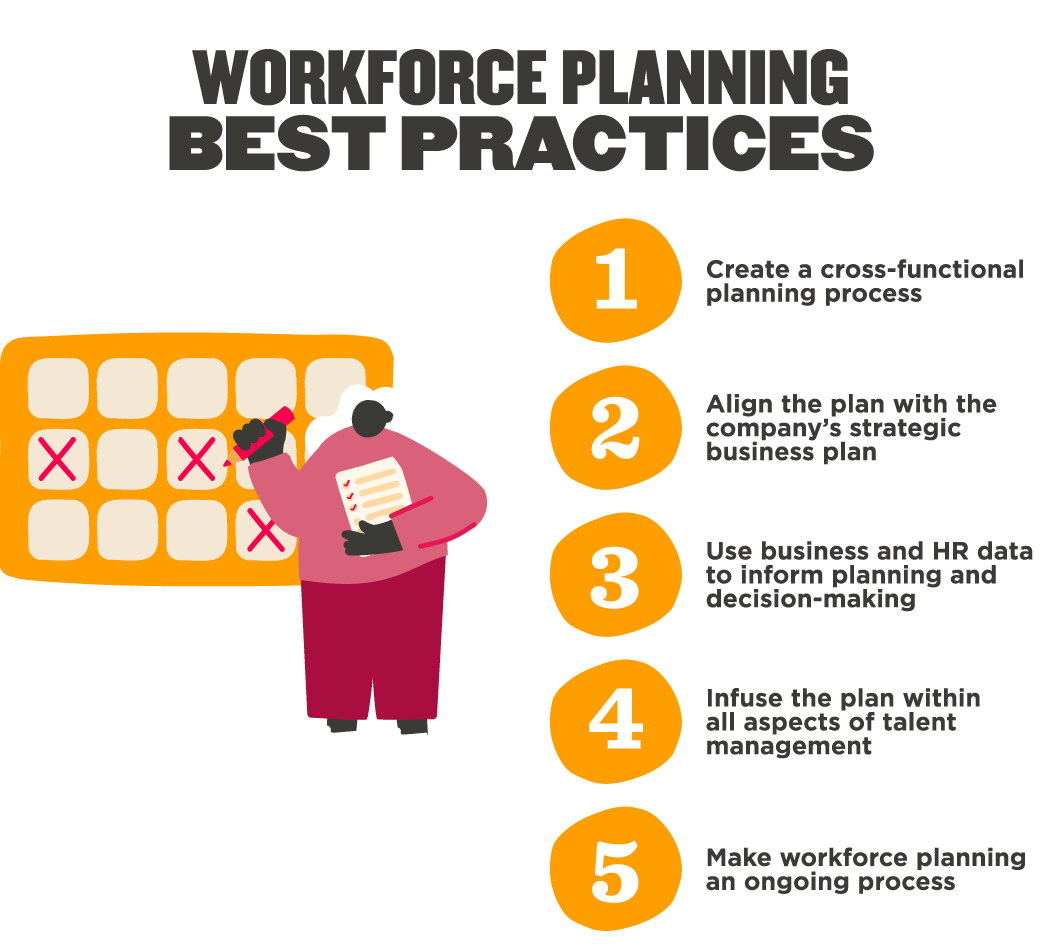It’s easy for the workforce planning process to feel like an overwhelming task, especially given the unpredictability of the world we live in. Planning for what lies ahead can feel like it requires nothing short of a crystal ball.
However, in times of uncertainty, strategizing and planning for your future workforce is even more important. In fact, a recent survey found that 61 percent of surveyed boards of directors rated workforce planning as an extremely important talent issue.
You don’t need a crystal ball. With some thought, discussion, and data, organizations can use workforce planning to analyze and plan the steps required to prepare for future staffing needs. Simply put, workforce planning can help your business have the right people in the right positions at the right time.
“Workforce planning is not just about hiring new people; it’s [also] about the gaps between what you currently have and what you need,” Jeremy Eskenazi, SHRM-SCP told the Society for Human Resource Management (SHRM). “If you do it right, you can discover who is capable of stepping into new roles with training and development and who may not be able to stay on in a job because the required skill sets are changing. Workforce planning is about all movement—up, down, in, out, or across the organization.”
A strategic approach to the workforce planning process encompasses recruitment, employee development, talent management, and finance. When all of these facets align with the company’s long-term objectives and goals, workforce planning can effectively help drive the business forward.
<<Download these free workforce planning templates to simplify planning.>>
What is workforce planning?
Workforce planning is a way of assessing your organization’s current and future needs and creating a strategy for the people you require to serve those needs.
In short, it’s a process that ensures you have the right people in the right roles, at the right time. Workforce planning is an effective way of looking at your current setup as well as into the future to make sure that you:
- Consistently have the right number of people for your workload
- Are prepared to replace retiring team members with skilled professionals
- Have people with the key skills and competencies your teams need to operate effectively
- Can be flexible and agile depending on changing organizational needs
- Are being efficient with your staffing costs and optimizing your output
Accurately forecasting what your business will need requires careful consideration and, in today’s climate, the preparation of a number of flexible plans based on data from your current workforce. Done right, workforce planning will ensure that your business always has the right amount and mix of talent to move you towards your wider strategic goals.
What is the goal of workforce planning?
Workforce planning supports senior leadership in building a coherent plan for the future and understanding the relative risk of each significant business decision. The primary aim is to create a strategy or series of strategies that shape how you will staff your teams over a number of years, as well as how you will respond to different circumstances.
A workforce plan provides:
- Metrics that allow senior management to identify risks before they make an impact
- Clear analysis of your current team’s skill sets and any challenges that might lie ahead
- An understanding of the advantages you may have over the competition—which can inform your recruitment strategies

Workforce planning benefits
Workforce planning is important to give your organization the flexibility it needs. If you have a pipeline of staff ready to step up and step in as people retire or move on, you can seamlessly reshape your teams to support business changes.
Detailed workforce planning allows you to:
Fill current workforce gaps
Workforce planning helps you identify and respond to gaps in your team. Analyzing your current setup and forecasting future needs helps you address missing skills, roles, or capacities before they affect performance. This means your teams will always have the expertise they need to succeed without serious disruptions.
Reduce costs
Effective workforce planning helps you stay ahead financially and strategically. By forecasting future talent needs based on business goals and market trends, you can proactively align headcount with actual demand. This reduces recruitment costs by minimizing the need for urgent, last-minute hires, which are often more expensive due to agency fees or rushed decisions.
Structured planning also simplifies onboarding by enabling HR teams to prepare resources and training in advance, reducing time-to-productivity. In addition, anticipating workforce changes—such as retirements, promotions, or attrition—helps avoid the costly cycle of high turnover by building internal pipelines and supporting retention strategies.
Improve diversity and inclusion
A diverse team brings fresh perspectives and drives innovation, strengthening your organization’s culture and impact. Workforce planning plays a critical role in building a more inclusive and equitable workplace by embedding diversity, equality, inclusion, and belonging principles into every stage of the employee lifecycle.
Evaluating workforce demographics highlights representation gaps across roles, departments, and leadership levels. It can also uncover opportunities for internal mobility and growth, helping underrepresented professionals access meaningful career development.
These insights empower HR and people leaders to take deliberate action—setting diversity goals, rethinking job descriptions, and expanding sourcing strategies—to create fairer hiring and promotion processes.
Strengthen talent management
Proactive workforce planning goes hand in hand with talent development. When you align planning with talent management, you can offer training, mentorship, and growth opportunities that meet your team’s evolving needs. This approach builds skills, boosts morale, and helps retain top talent across your organization.
Increase workplace flexibility
With strategic workforce planning, you can build agility into your operations by proactively aligning talent strategies with evolving business needs. Planning ahead allows you to assess which roles can be structured for flexibility—whether through remote work, hybrid schedules, or contingent contracts—based on function, performance expectations, and market conditions. This foresight enables your organization to pivot quickly as priorities shift, such as scaling up during periods of growth or streamlining during downturns, without compromising productivity.
Effective workforce planning also gives teams the structure and clarity they need to adopt new models smoothly, helping you meet changing employee expectations while maintaining operational continuity. In short, workforce planning lays the foundation for a more responsive, resilient organization.
Mitigate compliance risks
Workforce planning is more than headcount forecasting—it’s a proactive strategy for minimizing compliance risks. Embedding regulatory considerations into hiring, scheduling, and team structuring helps HR and operations leaders stay ahead of potential issues.
Accurate forecasting also helps manage workloads to prevent overtime violations and supports equitable compensation practices by aligning roles and pay scales with internal and external benchmarks. HR and legal teams that plan in advance have the time and visibility to adjust to changing regulations across jurisdictions, whether related to labor laws, benefits, or reporting requirements.
Prepare for future growth and development
Workforce planning helps your organization scale with confidence. Anticipating growth and staying ahead of industry trends ensures your teams are ready for what’s next. This forward-looking approach drives adaptability and positions your business to thrive in a competitive landscape.

Common workforce planning challenges
There are some common challenges that can impact how you map out the people and positions your organization needs to succeed now and in the future. Here are some of the hurdles companies typically face when conducting a strategic workforce planning process and how to prevent them from derailing your own efforts.
- Sudden, unexpected internal and external changes. As recent years have demonstrated, unanticipated requirements and changes can severely impact your staffing needs. An effective workforce planning process should be able to adapt quickly when changes do happen. To prepare as much as possible for unexpected changes, Tim Dowd, CEO of Accurate Background suggests that “the best advice is to plan as much as possible as early as possible for hiring needs. Thoughtful, well-established hiring strategies will allow businesses to address multiple scenarios to continue to run and thrive.”
- Manual processes and separate business unit planning. To be effective, workforce planning cannot happen in a vacuum. It should be informed by—and aligned with—your company’s overall strategic planning efforts. To maximize internal talent, it’s essential that cross-functional business teams partner in this process so team members’ skills can be leveraged throughout the company. Additionally, relying on manual functionality and outdated tools will slow down the process and make planning less effective.
- Lack of data analytics. Meaningful data analysis is required for successful planning and forecasting. It’s important not only to access the data but to leverage data in a way that helps determine the best strategy for workforce planning. Respondents to a recent survey expect reliance on talent data to increase. However, two-thirds of these respondents are dissatisfied with how their current HR solution manages talent data. One area to focus on is ensuring that you have people involved in your process of workforce planning who understand predictive analytics and can use data visualization to support informed decision-making.

Key aspects of workforce planning
Effective and strategic workforce planning involves gathering information, forecasting, analyzing, and evaluating four key issues.
1. Strategic direction: How to achieve business alignment
Strategic workforce planning begins with a clear understanding of your organization’s mission and long-term goals. Start by identifying the capabilities you’ll need to grow—whether that’s entering new markets, launching products, or adopting new technologies.
With this foundation, you can build a workforce that’s equipped to deliver on your vision, both today and in the future.
2. Workforce supply analysis: What your current workforce looks like
Workforce supply analysis gives you a clear picture of your current team. It starts with evaluating your people’s skills, roles, and capacity. With this insight, you can pinpoint key strengths and identify gaps, helping you make informed decisions about where to invest, restructure, or upskill.
3. Workforce demand analysis: How to anticipate future needs
Not only is it important to ensure your workforce is equipped to meet current goals, but your workforce planning also needs to consider what the workforce will look like in the future.
In recent years, for example, “unbossing,” or thinning out middle management roles, has become more common as companies attempt to cut down on costs and boost innovation. Changes like this signal the need for proactive analysis of your current positions and the people who fill them so that you can determine where changes will be required to meet future business objectives.
4. Workforce gap analysis: The gaps between your current and future organization
To identify gaps, assess the roles required and what skill sets are needed to perform them. Then, determine whether these skills are available within your current workforce. During this gap analysis, consider reskilling and/or upskilling. Upskilling provides your people opportunities to progress in their careers, while a reskilling effort allows existing people to learn new skills in order to perform different roles within the organization.
Succession planning is also an effective way of minimizing the gap between your current and future needs. Incorporating a succession strategy into your overall workforce planning can help minimize potential disruptions resulting from retirement, resignations, or transfers within the company.
<<Download these succession planning templates to start building your plan.>>
5. Solution implementation: Building recruiting and training plans
Once your workforce goals are clear, the next step is to shape a recruiting and training strategy that supports them. Whether your organization is expanding, contracting, or restructuring, your approach should reflect the direction of the business and the realities of the labor market.
Start by analyzing how key roles are evolving across your industry. Technological advancements—such as automation and artificial intelligence—are changing what businesses need from their teams. Automated HR tools can handle tasks that were once human-led, creating demand for professionals with cross-functional skill sets. At the same time, the rise of remote work has broadened access to global talent, making it easier to find the right fit, regardless of location.
In some cases, expanding your team doesn’t mean hiring full-time staff. Contingent staffing—through temporary roles, part-time professionals, contract workers, or consultants—offers flexibility when workforce needs are fluid. As more companies turn to contingent talent, it’s essential to integrate these professionals into your long-term workforce strategy, not just as stopgaps but as valuable contributors to business outcomes.
6. Monitoring progress: Implementing continuous performance tracking and improvements
Monitoring progress is about ensuring your workforce strategies are delivering the desired outcomes. Regularly track key workforce planning metrics to confirm that your plans are addressing workforce gaps and aligning with business goals. Tools like data analytics can provide insights into what’s working and where adjustments are needed.
Continuous improvement is essential. Use feedback from your team and data from your workforce planning efforts to refine your strategies. Staying flexible and open to change ensures your workforce remains aligned with your organization’s evolving needs.
<<Use these free workforce planning templates to get your strategies up to speed.>>
Workforce planning example
These days, smart HR leaders realize that having a workforce plan targeted at just one possible future isn’t enough. Instead, they’re building multiple plans that allow them to be flexible and agile in their approach to future needs.
Let’s imagine you’re in a senior HR position at a scale-up. With the company evolving rapidly, launching new products, and reaching into new marketplaces, you’ve got regular workforce planning to think about and potential periods of high-intensity hiring that will require a substantial investment in staffing.
The first of your plans might focus on rapid expansion into a new market, for which you’ll be required to attract qualified talent quickly and effectively to support the business’ success. This type of strategy will naturally focus on recruitment but also analyze your current teams to identify those with the potential to step into leadership or management roles.
A second plan may instead focus on how you can make only a few key hires in that new area of business while otherwise relying on contingent workers to support the surge in workload. This type of strategy requires building even more agility into your structure and also demands more of your HR team in the form of people management and the regular updates that senior stakeholders will require.
Finally, a third plan may outline a pause on hiring, instead outlining ways of upskilling and reskilling your existing people. In this example, your business may focus on a slower growth model, building loyalty with existing customers and reaching deeper into market segments already familiar with its products and services.
In each of these example scenarios, it’s important to think about where you are now, the skills and competencies you have available to you, and what you are likely to need, given the expected outcome. Analyzing the gap between these elements, alongside any upcoming retirements or people looking to change their role in the business, can help you make clear plans for your recruitment, retention, and people management strategies that stay firmly within your budget.
Workforce planning best practices

Once you understand the current workforce issues and the challenges you may encounter, you’re ready to start the workforce planning process. As with any process, flexibility is key, but we have five workforce planning best practices we recommend to ensure you’re prepared.
1. Create a cross-functional planning process
HR, finance, and operations must work in partnership to develop a strategic workforce plan, identify new roles or eliminate roles, and then map out a specific action plan for recruiting, hiring, training, and retaining talent. An effective workforce planning process should be led and managed by a designated HR team and composed of high-level executives from each business area, as well as operations and legal stakeholders.
2. Align the plan with the company’s strategic business plan
Identify the current workforce state as well as the future state needed to achieve your strategic objectives. First, conduct a current state assessment to gain an understanding of existing resources. More than just headcount planning, this analysis should consider the existing people’s current skills and their development paths.
With the information gleaned from the current workforce analysis, the next step is forecasting the type of workforce your organization will need to meet the identified business goals and objectives. This process should also take into consideration factors such as technological advancements and potential expansion or reductions in global marketplaces.
3. Use business and HR data to inform planning and decision-making
It’s crucial to have the right technology and tools in place to gather the data needed to perform these analyses. Talent realities change continuously, and companies that can adapt their hiring strategies accordingly can maintain a competitive advantage.
The good news is that there are workforce planning tools available to assist businesses in leveraging their existing data to create accurate forecasts, run predictive models, and help plan, track, and implement changes in the workforce. A cloud-based platform that includes fast and easy workforce planning options, such as easily collecting and analyzing team member skills and experience data, will help ensure effective workforce planning efforts.
Some companies are also investing in external data and “workforce sensing” resources to better assess the talent market. However, such workforce sensing capabilities require a significant time investment to gain an understanding of external data sources—something that HR teams may not be prepared to do.
4. Infuse the plan within all aspects of talent management
The plan impacts all aspects of talent management: recruiting, onboarding, developing, retaining, and outsourcing. Once workforce gaps have been identified, thoughtful evaluation of how to best fill those gaps should include a holistic approach to talent management that considers the skills needed and whether those skills are available within the current workforce. If internal talent isn’t available, the next step is determining whether those needs should be filled by recruiting new talent, retraining existing talent, or hiring a contingent worker.
In a time when more people work remotely, reliance on contingent workers is growing, and “super jobs” in which people straddle multiple skill sets are becoming more prevalent, defining how an organization manages not just recruiting but reskilling—and even reassigning—team members should be included in the overall workforce planning process.

5. Make workforce planning an ongoing process
The workforce planning process needs to be agile and adaptable in real-time to both the external environment and internal staffing needs. This effort is no longer an annual event. Companies need to engage in an ongoing planning process with shorter time frames.
“It needs to be very flexible, because oftentimes the business’s priorities change, even in a short time,” Eskenazi told SHRM. “The business is constantly resetting—and faster than ever before.” Eskenazi recommends that workforce planning teams routinely engage with leadership for input and then make modifications and update the plan.
Approaching workforce planning strategically, with an eye on the organization’s long-term objectives, and from a collaborative, analytics-driven perspective gives businesses the ability to adjust and adapt to increasingly changing business needs.
Implementing an effective and agile workforce planning process can create an optimally staffed and trained workforce that can respond to the needs of the business and minimize risk from unforeseen disruptions.
<<Use these free workforce planning templates to simplify strategy development.>>
Workforce planning models, methods, and tools
The workforce planning process relies on a variety of methods and tools to help organizations align their people strategies with their business goals, including:
HR software
HR software streamlines workforce planning by automating processes and providing valuable insights. Workforce planning tools in human resources platforms allow HR teams to analyze data, identify gaps, and forecast future needs efficiently.
An effective HR platform can highlight which team members have the skills to fill emerging roles, making it easier to plan for growth or restructuring. It can also integrate with other systems, providing a seamless approach to aligning workforce strategies with your organization’s broader goals.
9-box grids
The 9-box grid is a straightforward framework for assessing team members’ performance and growth potential. It’s a visual tool that categorizes people into nine segments, helping HR teams and managers identify high performers, future leaders, and areas for development.
For example, someone in the high-potential and high-performance quadrant might be ready for a leadership role, while a team member in the low-potential and low-performance area may need more support or a role adjustment. Regularly using this tool can keep your workforce planning on track by ensuring your talent strategies align with business goals and address development needs.
Workforce planning models
Established strategic workforce planning models give organizations a structured approach to understanding and addressing workforce needs. HR leaders can leverage these models to better anticipate changes, allocate resources, and align people strategies with business goals.
- HCI model: The Human Capital Institute (HCI) model focuses on aligning workforce strategies with business priorities. It emphasizes identifying key roles, forecasting workforce needs, and bridging gaps in skills and resources. This model encourages HR leaders to integrate workforce planning into broader talent management initiatives, ensuring teams are prepared for both current and future demands.
- U.S. Office of Personnel Management (OPM) model: The OPM model, originally developed for federal agencies in the United States, is a comprehensive framework that includes five key phases: strategic direction, workforce analysis, action plan development, implementation, and monitoring and revising. Its structured approach ensures workforce planning is data-driven and aligned with long-term goals.
- Flow model: The flow model examines the movement of people within an organization, such as hiring, promotions, internal transfers, and departures. HR leaders can analyze these dynamics to identify patterns and address areas for improvement. This model is particularly useful for understanding how talent moves within an organization and ensuring that transitions are smooth and well-supported.
- Optimization model: The optimization model uses data and analytical tools to allocate workforce resources efficiently. It focuses on balancing costs, skills, and capacity to meet organizational goals. This model is ideal for organizations looking to streamline operations while maintaining flexibility.
- Deterministic model: The deterministic model relies on fixed variables and predictable trends to forecast workforce needs. It assumes that certain factors, such as turnover rates or retirement patterns, remain consistent over time. While it’s less adaptable to rapid changes, this model works well for organizations operating in stable environments with consistent workforce dynamics.
- Equilibrium model: The equilibrium model aims to balance the supply and demand for talent within an organization. The model involves evaluating workforce availability against current and future needs to help HR leaders maintain stability. It’s especially useful in industries where demand fluctuates frequently, providing a framework for ensuring the organization is neither overstaffed nor understaffed.
HR dashboards
HR dashboards are indispensable for workforce planning. They pull together key metrics—like turnover rates, headcount trends, and skills inventory—into a unified view that’s easy to interpret. These dashboards simplify decision-making by giving you real-time insights into what’s happening across your organization.
If turnover spikes in a specific department, a dashboard can highlight it quickly, allowing you to take action before it impacts operations. The ability to visualize workforce data in one place keeps planning efficient and ensures your teams are always prepared for shifts in organizational needs.
Compensation and benefit analysis
Compensation and benefits are central to workforce planning because they directly influence your ability to attract and retain talent. A compensation strategy analysis helps you benchmark your pay and benefits against market standards, ensuring you consistently offer fair and competitive pay.
If your analysis reveals that your organization lags behind industry averages, you can adjust pay scales or enhance benefits to better support recruitment and retention. This proactive approach also helps you manage costs effectively while maintaining a satisfied and engaged workforce.
Scenario planning
Scenario planning is about preparing for the unexpected. It involves creating flexible plans for a variety of possible futures, helping organizations stay agile and ready for change. Whether it’s a sudden economic shift, advancements in technology, or scaling your business, scenario planning ensures you’re not caught off guard.
For example, if your business is considering automation, you can plan for the roles and skills that will still be needed while identifying where upskilling or reskilling might be required. Examining multiple scenarios can help you make informed decisions that keep your workforce aligned with your strategic objectives.
Using HR platforms to improve the workforce planning process
Traditionally, workforce planning is done in spreadsheets, external systems, or on paper records. While these may work well for sketching out initial ideas, it becomes extremely challenging to clearly align goals and tasks, track the execution of the plan, and deliver regular updates to key stakeholders. With information dispersed over several systems, a significant amount of effort is required to manually collect and compile findings at regular intervals.
If you’re using spreadsheets to complete the steps in workforce planning, it’s likely to be slow and time-consuming—and can lead to a greater number of human errors. Equally, spreadsheets won’t let you easily view your plan alongside your executed tasks or obtain a quick snapshot of your current status.
HR tech, on the other hand, lets you:
- Streamline your position planning. Convert spreadsheets into living processes with full visibility, analytics, and a high level of accuracy, so you can give your HR and finance teams everything they need to make clear and quick decisions.
- Empower your managers to be focused. Connect managers with your workforce planning strategy to give them the opportunity to evaluate their team’s productivity and skill set and to more easily build realistic plans for how they can meet their goals—rather than merely having to follow top-down directives.
- Keep everyone aligned with your strategic plans. Share access and increase visibility so the finance team and other executive stakeholders can tune in with your HR strategy, helping them plan, execute, and track your collective efforts.
HR tech brings together all elements of your workforce management to take a lot of the back-breaking manual work out of your strategy. With increased accuracy, transparency, and advanced analytic functions, it’s no surprise that businesses all over the world are turning to technology to supercharge their HR processes.
<<Download these free workforce planning templates to simplify planning.>>
Meet Bob
At HiBob, we’ve built a modern HR platform designed for modern business needs—today and beyond.
An HR platform such as Bob offers a one-stop shop for all things HR. It sits at the center of your HR ecosystem, is fully customizable, and grows with your organization.
For HR, it delivers automation of many common processes, allows greater oversight and visibility of the business, and centralizes all people data in a secure, user-friendly environment.
For managers, it provides access to data and insights to help them lead more effectively and streamline processes.
For team members, it’s the tools and information they need to connect, develop, and grow throughout their journey.
In a short time, Bob can be deployed to enable communication, collaboration, and connectivity that drives stronger engagement, productivity, and business outcomes.
Workforce planning process FAQs
What is the difference between workforce planning and strategic workforce planning?
The difference between workforce planning and strategic workforce planning lies in their focus and timeframe. Workforce planning is about meeting your organization’s immediate needs. It ensures you have the right people in the right roles today, focusing on short-term goals like filling current gaps or adjusting to workload changes.
Strategic workforce planning, however, takes a broader view. It’s about preparing for the future—aligning your workforce with long-term business objectives and anticipating changes in the industry or your organization to help your team thrive in the years ahead. Think of workforce planning as addressing the “now” and strategic workforce planning as preparing for “what’s next.”
Recommended For Further Reading
How often should HR leaders revisit workforce planning?
HR leaders should revisit workforce planning on a regular basis to ensure it stays relevant and actionable. For most organizations, quarterly reviews are a good starting point. They allow you to assess progress, adjust for any changes, and keep plans aligned with business goals.
That said, businesses experiencing rapid growth, market shifts, or significant internal changes might benefit from more frequent check-ins—monthly or bi-monthly, for example.
Revisit workforce planning during pivotal moments, such as launching a new product, entering a new market, or restructuring teams. The key is to treat workforce planning as a continuous process, not a one-time task. Proactive HR leaders can respond quickly to challenges and opportunities as they arise.
What are the R’s of workforce planning?
The R’s of workforce planning—Right people, Right skills, Right roles, and Right time—serve as practical guidelines for building a strong and agile workforce.
- Right people: This means having professionals who align with your company’s culture, core values, and mission.
- Right skills: Workforce planning identifies what skills are needed to achieve your goals and ensures your teams are equipped. Whether through hiring, upskilling, or reskilling, having the right skills in place is essential for success.
- Right roles: Matching team members to the roles where they can contribute most effectively is critical. This ensures people are placed where they can perform at their best and support organizational objectives.
- Right time: Timing matters. Workforce planning ensures you’re ready to meet both current and future demands, so you have the right talent in place when and where you need it.
